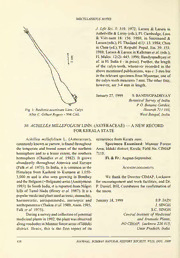
Achillea Millefolium Linn. (Asteraceae): a new Record for Kerala State PDF
Preview Achillea Millefolium Linn. (Asteraceae): a new Record for Kerala State
MISCELLANEOUSNOTES & J. Life Sci. 5: 310. 1972; Larsen Larsen in & Aubreville Leroy (eds.), FI. Cambodge, Laos & Viet-nam 18: 156. 1980, in Smitinand & Larsen(eds.),FI. Thailand4(1): 13. 1984; Chen in Chen (ed.), FI. Reipubl. Popul. Sin. 39: 153. 1988; Larsen& LarseninKalkmanetal. (eds.), FI. Males. 12(2): 445. 1996; Bandyopadhyay et al. in FI. India 6 - in press). Further, the length of the calyx-teeth, whenever recorded in the mm abovementionedpublications, was c. 3 but intherelevant specimenfromMyanmar, one of the calyx-teethmeasures 7 mm. The otherfour, mm however, are 3-4 in length. January 27, 1999 S.BANDYOPADHYAY Botanical Survey ofIndia, P.O. Botanic Garden, Fig. 1: Bauhiniaacuminata Linn.: Calyx Howrah 111 103, After C. GilbertRogers-994 CAL WestBengal, India. — 30. ACHILLEA MILLEFOLIUMLINN. (ASTERACEAE) A NEW RECORD FORKERALASTATE Achillea millefolium L. (Asteraceae), occurrence from Kerala state. commonlyknownasyarrow,isfoundthroughout Specimen Examined: Munnar Forest the temperate and boreal zones ofthe northern Area; Idduki district; Kerala; Field No. CIMAP hemisphere and to a lesser extent, the southern 7118. & hemisphere (Chandler et al. 1982). It grows FI. Fr.: August-September. abundantly throughout America and Europe (Falk et al. 1975). In India, it is common in the Acknowledgements Himalaya from Kashmir to Kumaon at 1,050- 3,000 m and is also seen growing in Bombay We thank the Director CIMAP, Lucknow andtheBelgaon(=Belgaum) areas(Anonymous for encouragement and work facilities, and Dr. 1985). In SouthIndia, it isreported fromNilgiri P. Daniel, BSI, Coimbatore for confirmation of hills ofTamil Nadu (Henry et al. 1987). It is a the taxon. popularmedicinalplantusedastonic,stomachic, haemostatic, antispasmodic, antiseptic and January 18, 1999 S.P.JAIN antihepatotoxic(Thakuretal. 1989,Anon. 1985, J. SINGH Falk et al. 1975). S.C. SINGH Duringasurveyandcollectionofpotential Central Institute ofMedicinal medicinalplantsin 1992,theplantwasobserved andAromatic Plants, alongroadsidesinMunnarforestareasofIdduki PO CIMAP, Lucknow226015, district. Hence, this is the first report of its UttarPradesh, India. 458 JOURNAL, BOMBAYNATURAL HISTORYSOCIETY, 97(3), DEC. 2000 MISCELLANEOUSNOTES References Anonymous(1985):TheWealthofIndia.RawMaterials Achilleamillefolium L.JournalofPharmaceutical (Revised)PublicationsandInformationDirectorate, Sciences64(11): 1833-1842. CSIR,NewDelhiIA:54-55. Henry,A.N.,C.R. Kumar& V. Chitra(1987): Floraof Chandler, R.F., S.N. Hooker & M.J. Harvey (1982): TamilNaduI.AnalysisVol. 1.Botanical Surveyof EthnobotanyandPhytochemistryofYarrowAchillea India,Coimbatore. millefoliumCompositae.Econ.Bot. 36:203-223. Thakur, R.S., H.S. Puri & A. Hussain (1989): Major Falk,A.J.,S.J.Smolenski,J.Baver& C.L.Bell(1975): medicinal plants of India. Central Institute of Isolationandidentificationofthreenewflavonesfrom MedicinalandAromaticPlants,Lucknow. — 31. NEW RECORD OF PLANTS FROM ORISSA II Orissa is rich in plant wealth. The state cmwide. Spikes terminal, slender, flaccid, 5-10 has 13 districts. Koraput district, a part of the cm long, many flowered, black after drying. Eastern Ghats, lies on the border of Andhra Corolla hypocrateriformis, white. Filaments PradeshandMadhyaPradesh.Haines(1921-25), white. Styles included, white. & apioneerexplorer,collectedveryfewplantsfrom FI. Fr.: May-December. this district, though it is floristically rich. Later Specimen examined: Similguda on, Mooney (1950) wrote on plants collected (Koraput), coll. H.N. Subudhi, 8454 mostly from Western Orissa. During an Remarks: Commonly grows along the ethnobotanicalsurvey,theauthorcollectedsome road side; has white flowers. plantsfromthisdistrict. Oncomparisonwiththe Distribution: Jamaica, Brazil, Argentina, literature, and the specimens available at the Sri Lanka, Malaya. Central National Herbarium (CAL), 3 taxa turnedouttobe new records forOrissa. Correct Ipomoea indica (Burm.) Merrill nomenclature, brief diagnostic characters, Int.Rump.Herb.Amb.495, 1917;Fosberg, phenology, collection site, field numbers and Micronesica2: 151, 1967;etinBot.Notiser 129: notes on the ecology and distribution of these 35-38, 1976; Bhandari. FI. Ind. Desert. 228, f. taxa have beenrecorded. 90, 1990; ConvolvulusindicusBurm. inRumph. Herb. Amb. Index Universalis, 7: 6, 1755; Stachytarpheta dichotoma (Ruiz & Pav.) Vahl Ipomoea congesta R.Br., Prod. 485, 1810; Van Enum. pi. 1: 207, 1804; forma albiflora Ooststr., FI. Mai. 4: 465, 1953. (Moldenke)Moldenke,Phytologia28: 102, 1974; Family: Convolvulaceae. MoldenkeinDass. andFosb., FI. Ceylon4: 264, Twiners, sometimes rooting at nodes, 1983; Stachytarpheta australis forma albiflora denselypilose.Leavesbroadlyovatetoorbicular, Moldenke, Phytologia 3:63, 1949; Verbena entire, 5-12 x 3-5 cm, cordate at base, shortly dichotoma Ruiz& Pav., FI. Peru andChil. 1:23, acuminate; petioles 2-15 cm long. Retrosely pi. 34b, 1798. hairy. Inflorescence axillary peduncle, more or Family: Verbenaceae. lessretroselypilose.Flowersinumbellatecymes; mm Annuals; branches dichotomous, obtusely pedicels 2-8 long. Sepals herbaceous, 10- tetragonal, light grey; branchlets densely 20 cm long. Corolla funnel shaped, glabrous, pubescent. Leaves opposite, decussate; leaf brightblue.Stamenandstyleincluded,withhairs blades membraneous, elliptic to ovate, acute, atbase. Ovary glabrous. serrate along the margins, 1.5-6 cm long, 1-3 Fl.-Fr.: June-October. JOURNAL, BOMBAYNATURAL HISTORYSOCIETY, 97(3),DEC. 2000 459
